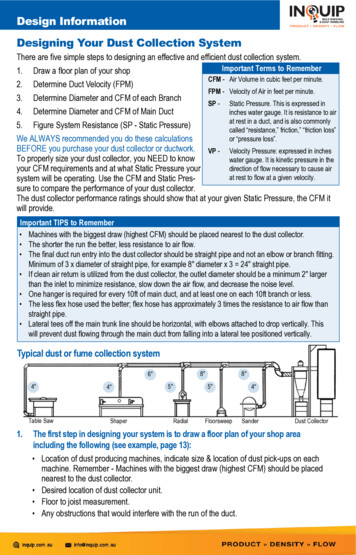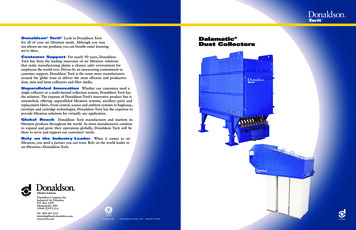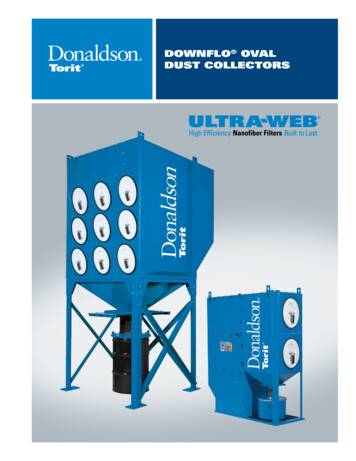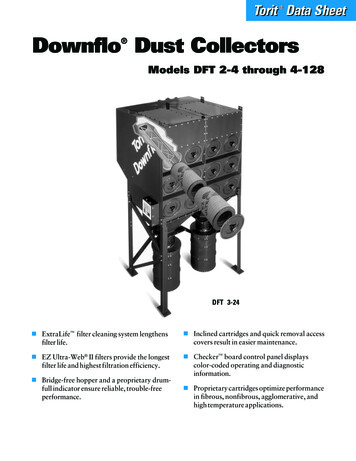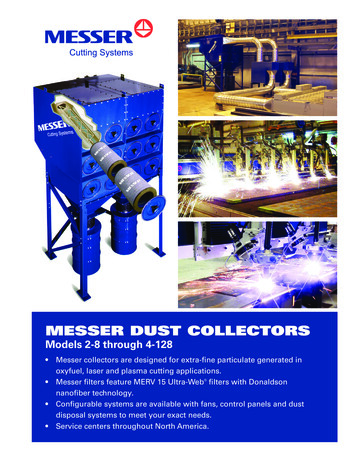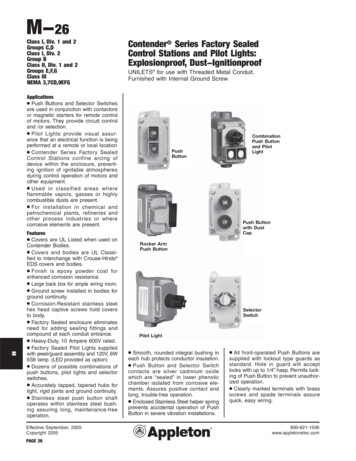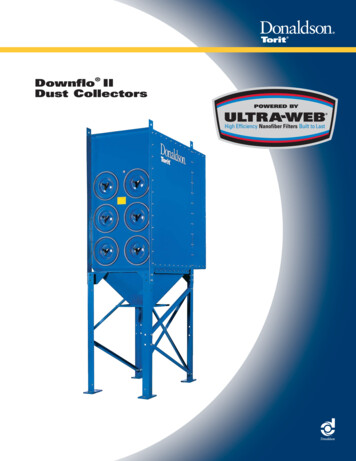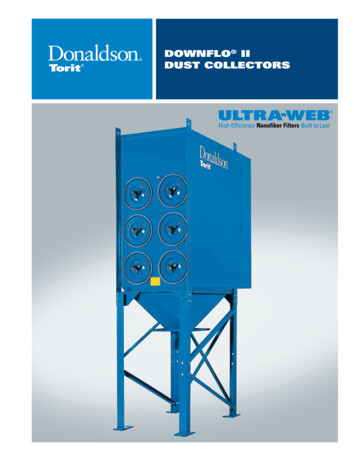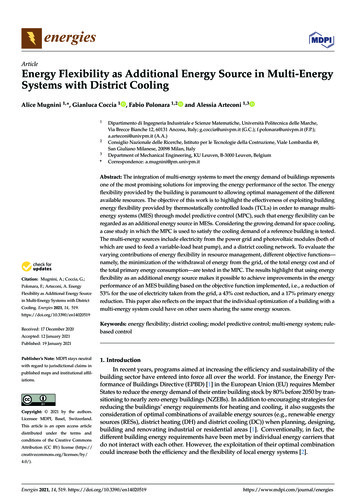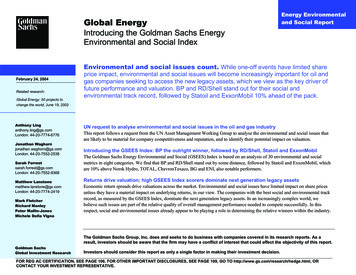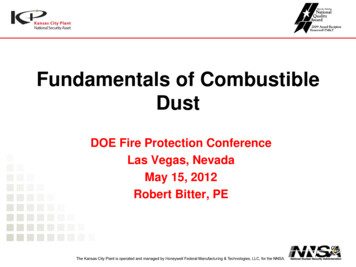
Transcription
Fundamentals of CombustibleDustDOE Fire Protection ConferenceLas Vegas, NevadaMay 15, 2012Robert Bitter, PE
All data prepared, analyzed and presented has been developed in a specificcontext of work and was prepared for internal evaluation and use pursuant tothat work authorized under the prime contract between the U.S. Departmentof Energy and Honeywell Federal Manufacturing & Technologies. LLC.Reference herein to any specific commercial product, process or service bytrade name, trademark, manufacturer, or otherwise, does not necessarilyconstitute or imply its endorsement, recommendation, or favoring by theUnited States Government, any agency thereof or Honeywell FederalManufacturing & Technologies, LLC.
Existing Facility 136 land acres38 buildings3.2M sq. ft. 3.0B totalvalue 50 MFLareasLargest MFL 250M 2510 FTES
New Facility(will be completed this year) Leased bldg. Located in southKC7 miles south ofcurrent facility191 land acres5 buildings1.5M sq. ft. 650M bldg. cost 1.2B total projectcost (includingmove cost)ManufacturingBldg. MFL–– Manuf. – 411MStores - 1B 3200 FTESMove –in––Start 1/2013End 7/2014
Back to Combustible Dust
Recent Grain Elevator Explosion Atchison, KS– 50 miles NW ofKCOct. 29, 2011Bartlett Grain6 killedOSHA fine 406K–––Accumulation ofgrain dustRemoving dustwithout shuttingdown electricalOrdinary electrical
Other Major ExplosionsCTA Acoustics Corbin, KY2/20/2003 – 7 injuredResin dust ignited by ovenImperial Sugar, Savannah, Georgia 2/7/08 14 dead – 38 injuredAccumulation of sugar dust in packagingWest Plains Pharmaceutical Kinston, NC2/29/2003 – 6 dead – dozens injuredPlastic powder above suspended ceiling ignitedAlthough we don’t have this type of hazard, there can still be issues
Some Equipment Used at the KCP(and probably at your facility)Surface Grinder Tool RoomSmall Torit for Bench Grinder
Some Equipment Used at the KCP(and probably at your facility)Plastic Media BlasterPmax 5.24 barKst 58MIE 5 kJLow Kst with high ignition energy pretty safe but ?
Some Equipment Used at the KCP(and probably at your facility)SS White Glove boxAir abrasive jet machineconnected to a 2x2x3Torit dust collectorKst - 23
Some Equipment Used at the KCP(and probably at your facility)Transverse Saw CE68074Is this stuff combustible dust?Fire hazard but not explosion hazard
Some Equipment Used at the KCP(and probably at your facility) Nylon powder asfine as flourMIE 7 mJ
Some Equipment Used at the KCP(and probably at your facility)Clean Room Central VacuumIs this stuff combustible dust?
Dust Explosion Basics
What is a Combustible Dust? Old definition – size matters– Particles 420 micron (µm)– 420 micron 0.0165 in. Current definition - A combustible particulate solid thatpresents a fire or deflagration hazard when suspendedin air or some other oxidizing medium over a range ofconcentrations, regardless of particle size or shape.(no size indicated)Ya gotta test to be sure
Explosion Characteristics of Dust(Basic Dust Test)Characteristics of explosive dust normally fall within twogroups:1.Likelihood of an Explosion - Ignition sensitivity– Min Explosible Concentration (MEC)– Min Ignition Energy (MIE)2.Consequence of an Explosion - Explosion severity– Max Explosion Pressure (Kst)Combination of the likelihood and consequence defines the explosion risk
All Possible Test(initial test indicated)
Determining Pmax Standard TestMethod forPressure and Rateof Pressure Risefor CombustibleDustASTM E1226Igniter 5kJDustconcentrations areincreased toachieve maximumpressure (Pex)Pmax averageof 3 Pex
Pmax and KstKst Classes and ExamplesDustexplosionclass*Kst (bar.m/s)Characteristic00No explosion1 0 and 200Weak explosion2 200 and 3003 300Strong explosionVery strongexplosionTypical materialSilica, SodiumBicarb60/40 Carbon,Polyplus, sulfur,sugar and zincCellulose, woodflour, and polymethyl acrylatealuminum,magnesium* The actual class is sample specific and will depend on varyingcharacteristics of the material such as particle size or moisture.Maximum rate of pressure rise PmaxBecause Pmax is volume dependent, itIs converted to Kst to normalize independenof volumeKst (dP/dt)max x V 1/3KCP Dust InfoD/ 34 Carbon60/ 40 CarbonPlast ic MediaPolyplusCode requires system protection for Kst 0Kst34213412530MIE 479634 4796
Building Damage from Dust Explosion
Related NFPA Codes NFPA 484 Standard for Combustible Metals – 2012 NFPA 61 Standard for The Prevention of Fires and DustExplosions in Agricultural and Food Processing Facilities – 2008 NFPA 664 Standard for the Prevention of Fires and Explosions inWood Processing and Woodworking Facilities – 2012 NFPA 655 Standard for the Prevention of Sulfur Fires andExplosions – 2007 NFPA 654 Standard for the Prevention of Fire and Explosionsfrom Manufacturing, Processing and Handling of CombustibleParticulate Solids – 2006 NFPA 652 – Standard on Combustible Dust – just starting
Objective of NFPA 6544.5.1.1The facility, combustible particulateprocesses, and human element programsshall be designed, constructed, equipped,and maintained to protect occupantsnot in the immediate proximity of the ignitionfrom the effects of fire, deflagration,and explosion for the time needed toevacuate, relocate, or take refuge.Code Compliance May LeaveEquipment Operator at risk
Process Hazard Analysis (PHA) required4.2 Process Hazard Analysis.4.2.1* The design of the fire and explosion safetyprovisions shall be based on a process hazard analysisof the facility, the process, and the associated fire orexplosion hazards.4.2.2 The results of the process hazard analysis shall bedocumented and maintained for the life of the process.4.2.3 The process hazard analysis shall be reviewedand updated at least every 5 years.
Likelihood of Exposible Concentration (MEC)Likelihood of ignition (MIE)A Simplified Risk AnalysisKst
Air-Material Separators(dust collectors) Where an explosion hazard exists, dust collectorsshall be located outside unless provided with one ofthe following––––––Venting thru a LISTED flame-arresting deviceDilution with noncombustible dustExplosion suppressionExplosion pressure containmentExplosion ventingOxidant concentration reduction Or are 8 cu. ft. ( 55 gal) in volume
8 cu. ft. Controversy in NFPA 654 Paragraph 7.13.1.3 addressing protection requirements, states“air-material separators shall be protected in accordance with7.1.2.”– As the standard reads 7.13.1.3 is inclusive of all air-material separatorswhere an explosion hazard exists.– This includes air-material separators handling combustible dust with volumesless than 8 cubic feet, and equal to or greater than 8 cubic feet. Protecting units with volumes of less than 12 cubic feet, withventing or suppression may not be technically feasible. In order to meet the goals of 654, a risk analysis should beprovided for air-material separators located inside that handlecombustible dust. The consensus is that the code does not specifically require protection for 8 cu. ft.Yet unprotected 8 cu. ft dust collector may leave the operator at risk
Code Prescribed mersionSeparator
Flameless Venting
Immersion Separator Media submerged in aliquid bath Good for combustiblemetals
Protecting 8 cu. ft. dust collectors(if not located outside)1. Locate the dust collector at or near roof level thusremoving it from the immediate area of the operator.2. Build a barrier to separate the unit from the operator.3. Provide venting if No. 1 or 2 is not practical and the dustcollector must be physically near the operator.4. Use a Torit type dust collector that is designed to “shake”only if the unit is not operating and then use a timer suchthat the unit can only “shake” during off-shift orunoccupied times.Explosion Suppression won’t workfor Dust Collectors 12 cu. ft.
First Steps Do walk-thru looking for dust-producing and collectingequipment Check particle size - 420 microns? Do Kst and MIE test Do Process Hazard Analysis– Maybe more testing
Miscellaneous If you can’t clearly see thru it, you may have a problem. Although code is silent on this, the consensus is that dustcollector (air-material separator) size is determined by measuringthe volume of the dirty side (not the whole box). Reportedly, NASA did a study in the late 1990s of glove boxblasters using a variety of plastic combustible dust and walnutshells and concluded that this is not a hazard in that the dustcloud within the glove box is particularly too lean (not enoughsuspended dust) to explode. A risk exists if:––––Pmax 2 barProcess operates at 25% of MECMIE 30 mJThere is a credible ignition source including static
3/10/2012 Dust FireSpent Steel Shot ignites in the DustCollector of this Steel Shot Blaster(fire, not explosion)
Some Books to Read Dust Explosions in the Process Industries– Rolf K. Eckhoff– Gulf Publishing Guidelines for Hazard Evaluation Procedures– Center for Chemical Process Safety Layer of Protection Analysis (Simplified Process RiskAssessment)– Center for Chemical Process Safety
QUESTIONS ?
NFPA 484 Standard for Combustible Metals – 2012 NFPA 61 Standard for The Prevention of Fires and Dust Explosions in Agricultural and Food Processing Facilities – 2008 NFPA 664 Standard for the Prevention of Fires and Explosions in Wood Processing and Woodworking Facilities – 2012 NFPA 655 Standard for the Prevention of Sulfur Fires and Explosions – 2007 NFPA 654 StaFile Size: 5MBPage Count: 35
